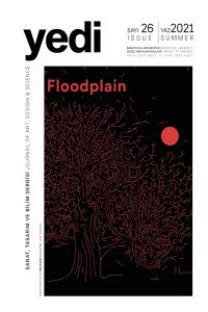Ürün ve UX/UI Tasarımında Öğrenci Yetkinliğinin Geliştirilmesi: Beş Aşamalı Yeniden Tasarım Stüdyosu Örneği
Bu makalede sunulan çalışma, eğitim bağlamında ürünün yeniden tasarlanması için sistematik bir yaklaşımın geliştirilmesi ve yaygınlaştırılması amacını taşımaktadır. Endüstride verilen tasarım iş tanımları genellikle iki kategoriden birine girer: yenilik veya kademeli iyileştirmelere dayalı yeniden tasarımlar. Bu çalışma, son sınıf endüstriyel tasarım lisans öğrencileri için özel olarak kurgulanmış yeniden tasarım stüdyosunu konu almaktadır. Stüdyo, sadece yeniden tasarımı ilginç bir faaliyet haline getirmekle kalmayıp, aynı zamanda öğrencilere ürün iyileştirmeye odaklanan herhangi bir projede kullanabilecekleri sistematik ürün araştırması ve analizine yönelik yeni bilgi ve beceriler kazandırmayı da hedeflemiştir. Öğrenciler yeniden tasarım stüdyosuna başlarken, iyileştirilmesi veya güncellenmesi gerektiğini düşündükleri kendi sahip oldukları ve kullandıkları bir elektrikli ev aleti veya elektronik ürünü seçtiler. Devamında, her birine has bilgilendirme sunuşu, etkinlik ve proje kritiklerini içeren beş ardışık proje aşaması boyunca yönlendirildier: (i) ürün anatomisi analizi ve bileşenlerin etiketlenmesi, (ii) pazar analizi ve pazar bölümlendirme grafiği, (iii) akran katılımlı uygulamalı kullanıcı deneyimi (UX) değerlendirmesi, (iv) ürün iyileştirme stratejileri (v) tasarım önerileri. Ardından, her aşama için eğitim hedefleri vurgulandı. Öğrenciler, UX değerlendirme aşamasını detaylı olarak raporladılar. Bu sırada UX terimlerini doğru kullanmak, değerlendirme verilerinin toplanmasına ve kullanıcı araştırmasının analiz edilmesine yardımcı olmak için yazarlar tarafından hazırlanan UX değerlendirme şablonundan yararlandılar. Şablon, ürün/kullanıcı arayüzü (UI) değerlendirmelerine yönelik yaygın İngilizce terimlerin Türkçe çevirilerine de yer veren on temel kriter içermekteydi. Öğrencilerin yeniden tasarım stüdyosunun güçlü ve zayıf yönlerine ilişkin görüşleri çevrimiçi bir anket aracılığıyla toplandı. Öğrenciler her ne kadar ertelemeye fırsat vermeyen, hızlı karar vermeyi gerektiren yoğun iş temposunu yönetmekte zorlansalar da, stüdyonun gerçek hayattaki tasarım pratiğine olan yakınlığını takdir ettiklerini özellikle vurguladılar. Yeniden tasarım stüdyosunun, radikal yenilikler yerine aşamalı ve gerekçelendirilmiş iyileştirmelerin istendiği durumlarda ürün tasarımı eğitimi için etkili bir yöntem olacağı önerilmektedir.
Anahtar Kelimeler:
: ürün tasarımı, ürün testi, yeniden tasarım, kullanıcı değerlendirmesi, UX/UI
Developing Student Competency in Product and UX/UI Design: The Case of the Five-Stage Redesign Studio
The purpose of the work presented in this paper was to develop and disseminate a systematic approach for product redesign in an educational context. Design briefs given in industry frequently fall into one of two categories: innovations, or redesigns based on incremental improvements. In the reported work, final year industrial design undergraduates were guided through a specially devised redesign studio. The studio set out not only to make redesign an interesting activity, but also to provide students with new knowledge and skills in systematic product investigation and analysis that could be used in any project focused on product improvements. Students entered the redesign studio by choosing a personally owned household electrical or electronic product that they considered in need of improving or updating. They were then guided through five consecutive stages of briefings, activities and critiques: (i) product anatomy analysis and part labelling, (ii) market analysis and market segmentation charts, (iii) hands-on peer contributed user experience (UX) evaluation, (iv) strategies for product improvement, and (v) design proposals. The educational aims for each stage are highlighted. At the UX evaluation stage, students used a special worksheet devised by the authors. The worksheet aimed to accelerate students’ comprehension of UX terms and assist the collection and analysis of user research data. The worksheet included ten key criteria for product/user interface (UI) evaluations, benefiting from translations of common English terms into Turkish. Students’ views on the strengths and weaknesses of the redesign studio were collected via an online survey. The closeness of the studio to real world design practice was consistently praised, although students found it difficult to deal with the intensity of the workload, which demanded rapid decision-making with no room for procrastination. The redesign studio is proposed to be a good approach for product design education where rationalized incremental product improvements are sought instead of radical innovations.
Keywords:
product design, product testing, redesign, user evaluation, UX/UI,
___
- Anderson, S. (2011). Seductive Interaction Design: Creating Playful, Fun, and Effective User Experiences. USA: New Riders.
- Creswell, J. W. (2014). Research design: Qualitative, quantitative, and mixed methods approaches. Los Angeles, USA: Sage.
- Çelik, H., Başer Baykal, N. ve Kılıç Memur, H. N. (2020). Nitel veri analizi ve temel ilkeleri. Eğitimde Nitel Araştırmalar Dergisi – Journal of Qualitative Research in Education, 8(1), 379-406.
- Demirbaş, D., & Timur Öğüt, Ş. (2018). Design briefs for industrial design studio courses: Determination of expectations and requirements, Eğitimde Nitel Araştırmalar Dergisi – Journal of Qualitative Research in Education, 6(2), 42-58.
- Hassenzahl, M. (2003). The Thing and I: Understanding the Relationship between User and Product, in M. Blythe, K.
- Overbeeke, A. Monk, & P. Wright (Eds.), Funology–From Usability to Enjoyment, 31-42. Dordrecht: Kluwer Academic Publishers.
- Joo, H. (2017). A Study on Understanding of UI and UX, and Understanding of Design According to User Interface Change. International Journal of Applied Engineering Research, 29931-9935.
- Kayhan, Özgür (2005). Yeni Ürün Geliştirme Sürecinde Tasarım İş Tanımı: Türkiye'deki Uygulamaların İrdelenmesi. (Yayınlanmamış yüksek lisans tezi), İstanbul Teknik Üniversitesi, İstanbul.
- Kovatcheva, E. (2018). User Experience Design Models for Internet of Things. Serdica Journal of Computing, 65-82.
- Norman, D.A. (2013). The Design of Everyday Things: Revised and Expanded Edition. New York: Basic Books. Yazarlar (2022).
- Rowland, C. (2015). User Experience Design for the Internet of Things: Why It's More than UI and Industrial Design. O'Reilly Media, Inc.
- United Nations (2021). Sustainable Development Goal 12: Ensure sustainable consumption and production patterns. Erişim adresi: https://sdgs.un.org/goals/goal12
- ISSN: 1307-9840
- Başlangıç: 2007
- Yayıncı: Dokuz Eylül Üniversitesi
Sayıdaki Diğer Makaleler
Nijerya Sanatında Hayvan Temsilleri: Roller, Önem ve Estetik Üzerine Bir İnceleme
Michael Abiodun OYİNLOYE, Adebayo Abiodun ADELOYE, Peter Oluwagbenga ODEWOLE, Benjamin Eni-itan F AFOLABİ
Kemeraltı Camilerinin Akustik Özellikleri
Halil YOLERİ, Şenay ÖZTÜRK OZAN
21. Yüzyılda Karşı Sanat Anlayışı Olarak Glitch
Bahar ŞENER- PEDGLEY, Owain PEDGLEY
Irkçılık ve Ayrımcılık Bağlamında Blackface Makyajı ve Mickey Fare Karakteri
Kilimin Ekfrasis ve Göstergelerarasılık Bağlamında Kullanımı: Ayla Çınaroğlu’nun Sihirli Kilim’i
Geleneksel Keçe ve Batik Teknikleri ile Deneysel Yüzey Oluşumları
Tülay Tura Börtecene’nin Sanatı ve Modern Türk Resmindeki Yeri
Seramik Malzemenin Dili ve Kimliğin Taşıyıcısı Olarak Parmak İzi Dokusu
